European Origins
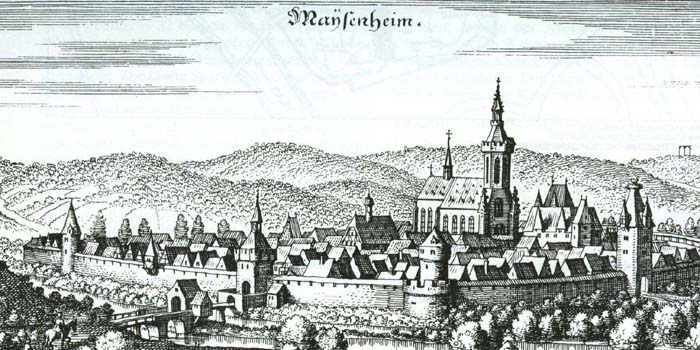
1645 Woodcut of the town of Meisenheim
The origin of the Mize family has not been factually proved but there have been theories that the birthplace
of the Mize name probably occurred in western Germany or eastern France and is of Celtic origin. The book, Mize Genealogy
in America states that the ancestral origins of the name Mize, Meis, or Meiss, probably originated in the Palatinate-Lorraine
region at the town of Meisenheim. This town was built during the years 700 A.D. through 800 A.D. The Glan River lies to the
south of this village and runs north and south in the Palatinate The Celtic root of the name for the Glan River comes from the
words Glann (shining) or from Glen (U shaped valley). During the thirty Years War, during the years 1618 to 1648, German
protestants suffered severe religious persecution within Palatinate-Lorraine. The region around the town and the town itself
was considered a spoil for the victors from other countries and states and in turn laid the land and its people to waste. This
weakened region never recovered from the pillaging and killing. During these times, the leadership of this region was no match
for France which had ravaged the area. There was much international concern, so much that Britain lead a coalition to oppose the
French occupation. This struggle became known as the War of Palatinate, the War of the Grand Alliance or the War of the League
of Ausburg. This war stretched from 1688 through 1697 and caused a grand exit of people from the war torn Palatinate land.
The protestant Huguenots exited in mass from the region and made stops in the British Isles and Britain itself before arriving
in the American Colonies. The families arriving in America probably took on the name Mise, Mize, Meis, or Meiss which were
derived from the township's formal name. This nicely fits with the first Mize, Jeremiah Mize, appearing in the Virginia colony
around the year 1694. Although there is no lineal proof of this occurring, this is the most likely scenario which would have occurred.
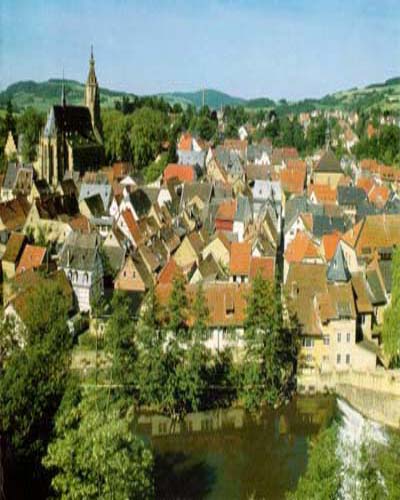
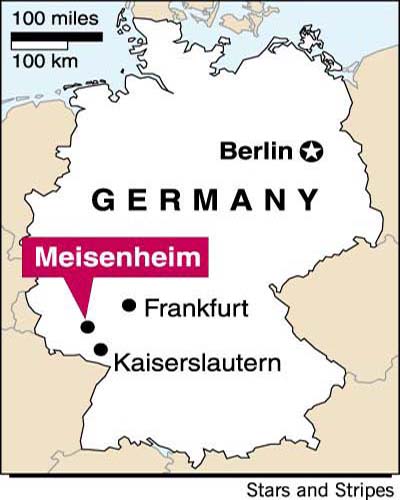
View of Meisenheim from the opposing hillside with the Glan river in the foreground. The schlosskirche is located on the left.
During my army career, I was stationed in the beautiful country of Germany. While living there, I searched throughout eastern France
and western Germany in hope of finding the village of Meisenheim. During an antique buying expedition in the Rheinland-Pfalz region,
I accidentally found the location of Meisenheim on an antiques guide brochure. I could barely believe my luck and I immediately planned
to visit this town the very next weekend. All week I readied myself with camera, maps, gas coupons, and a notebook. Meisenheim was less
than two hours drive from the small town of Erlenbach in which I lived. Erlenbach is about 10 miles from the major city of Kaiserslautern
where I was stationed at Panzer Kaserne.
The town’s name Meisenheim originates from two german words, meisen and heim. The literal translation means the home of meises. A Meise is a small sparrow like bird native to the area of present day Rheinland-Pfalz region in which the town is located. This bird is part of the town coat of arms.
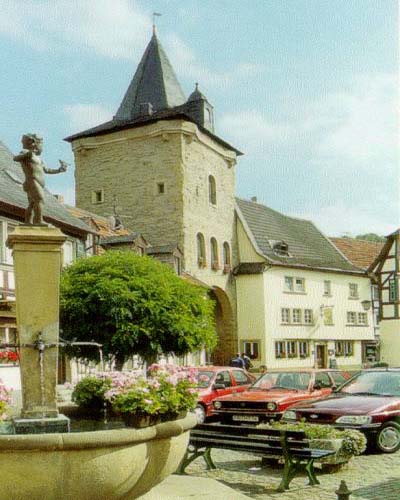
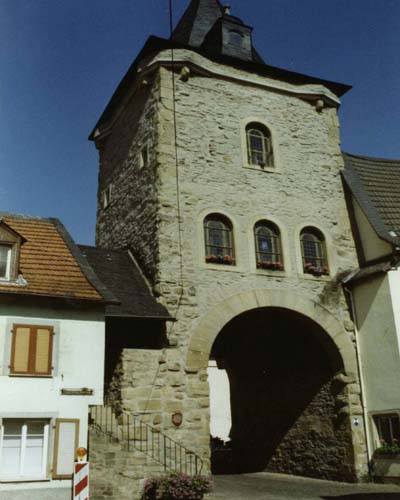
Village fountain and village gate
As I drove, I was incredibly excited to find the town nestled among grape vineyards and green rolling hillsides. The city was complete
with fortress walls and a “Turm”, a gated entrance which had to be driven through to enter the quaint town. The river Glan was crossed
via pull bridge to enter the the cobblestone main platz. I parked the car a.k.a. the hoopdy and proceeded to wander the narrow streets
with a camera. I was overwhelmed with the cleanliness and the superb upkeep of the ancient buildings within the walls of this aged town.
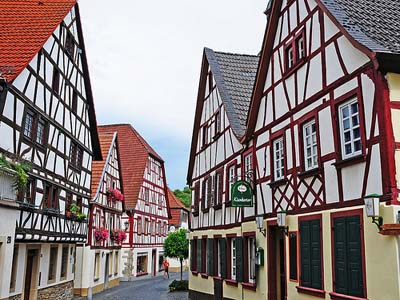
Side streets just off the main market plaza. The hanging green sign is for a Guest House where a meal and and a drink can be bought.

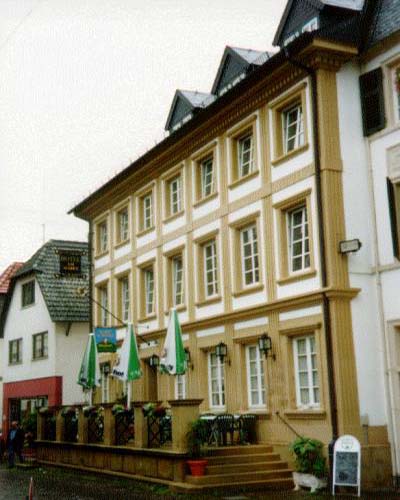
The left picture is of the Rathaus (city hall) that dates to 1517 which had the town shield upon the doors. As you can see the main
mode of transportation is by foot within the “altstadt” or the old town. The picture on the right is of the am Markt Hotel where
I rested from the day’s walk.
All the structures were hundreds of years old yet were in remarkable shape. I stopped at the Schlosskirche or Historic Church that was built around the year 1517. The up reaching spire of this church can be easily seen anywhere within the town and is the town landmark. The alter of this church was a supreme work of carved wood which was impossible to photo due to the light conditions within the church.
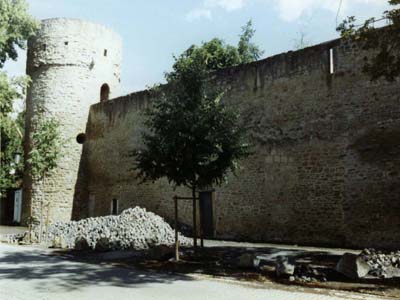
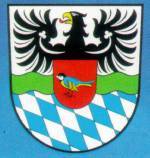
Fortress walls surrounding the city and the town Coat of Arms
As I walked the streets, I noticed that some of the buildings were built directly into the fortress wall which encircled the entire
town of Meisenheim. The town is surrounded by stone turrets and aged, time worn fortress walls. This is excellently represented by
the 1645 woodcut that is prevelantly displayed throughout the town. The streets are too narrow for most vehicles to travel freely
within the old town so foot travel is common along the main platz and the town’s side streets. I carried a burlap shopping bag under
my arm to claim several souvenirs at the local art shop located next to the Rathaus.
As you can see the main mode of transportation is by foot within the “altstadt” or the old town. The picture on the right is of the am Markt Hotel where I rested from the day’s walk. Personal shopping bags and umbrellas are a must for all persons living or traveling in Germany because when shopping you must bag your own purchases and because rain is such a common occurrence. After purchasing several trinkets and rememberance items, I stopped at a restaurant called Am Markt Hotel which was across the street from the Rathaus (town hall) to drink a cold apfelschorler. There is nothing better to cool a parched throat from extensive walking through a town’s cobble stone streets than a ice cold apfelschorler. An apfelschorler is a savory apple juice spritz which can be enjoyed anywhere in the region while partaking of the scenery. Quite ! Tasty! While sitting outside, I saw mounted on the double wood doors of the Rathaus across the street, the town crest which had the famous Meise bird painted upon it.

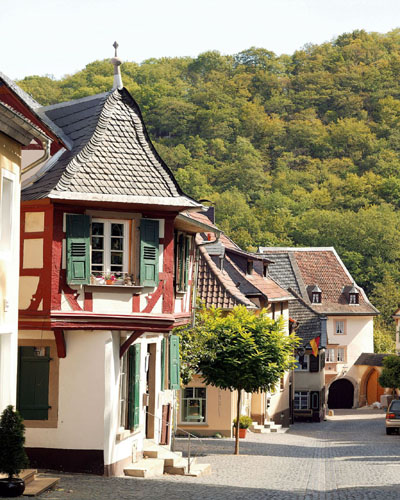
View of the Schlosskirche from main platz. Half-timbered houses within the walls of Meisenheim.
The entire town was surrounded by a “stadtmauer” which translates to a town wall. Parts of the fortress walls were the original
15th century walls while other parts of the walls were rebuilt to its original form.The turret seen in the left hand side picture
was the residence of the village burgher during medieval times. He oversaw the upkeep and maintenance of these walls that offered
protection for the town’s people from outside forces during the tumultuous era of the 1600’s wars. The walls had withstood the
horror of religious persecution along with foreign occupation, and wars in addition to thousands of deaths. Inside this fortress,
daily commerce was conducted beside a simple iron works, a multi-story grain millery which was located on the Glan, an apothecary,
and a market place. All these buildings were still present but filled with new commercial businesses. Flower shops, restaurants,
guest houses, and an art shop were located in these buildings. Surprisingly there were Catholic and Protestant churches within sight
of each other. It is ironic that they are so close in proximity to each other because of the Catholic church’s religious persecution
of the protestants which caused the Huguenot exodus. This town was filled with slow unique combination of the new and the old Germanic
charm along with dozens of half timbered structures normally seen only on post cards. It was a memorable experience which I shall not
forget. I believe that all Mize family members should take the time to visit this historic landmark in our Celtic family history not only
to enjoy the cultural experience of the Palatinate but to visit other countries that have figured so prominately in our family lineage.
Our family names of Lay, Bryant, Wilson, Buchanan, Calder and others are of the same Celtic origins but migrated from the different areas
of Scotland through Ireland to the new world into the heavily Scots Irish settled Appalachia region of eastern Kentucky. Maybe one day,
Scotland……